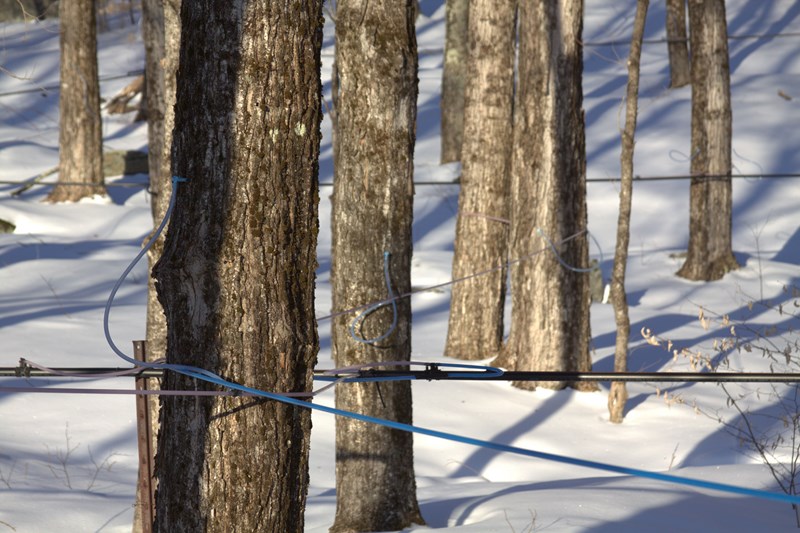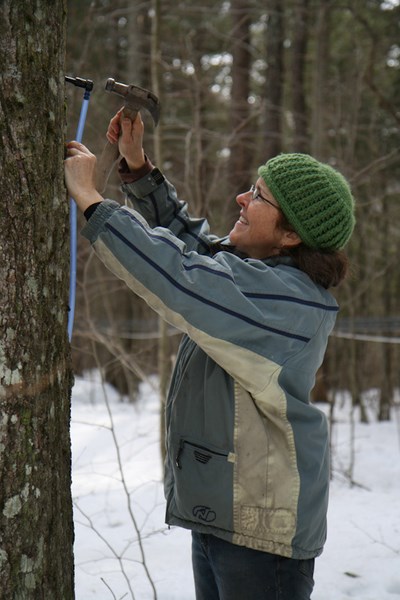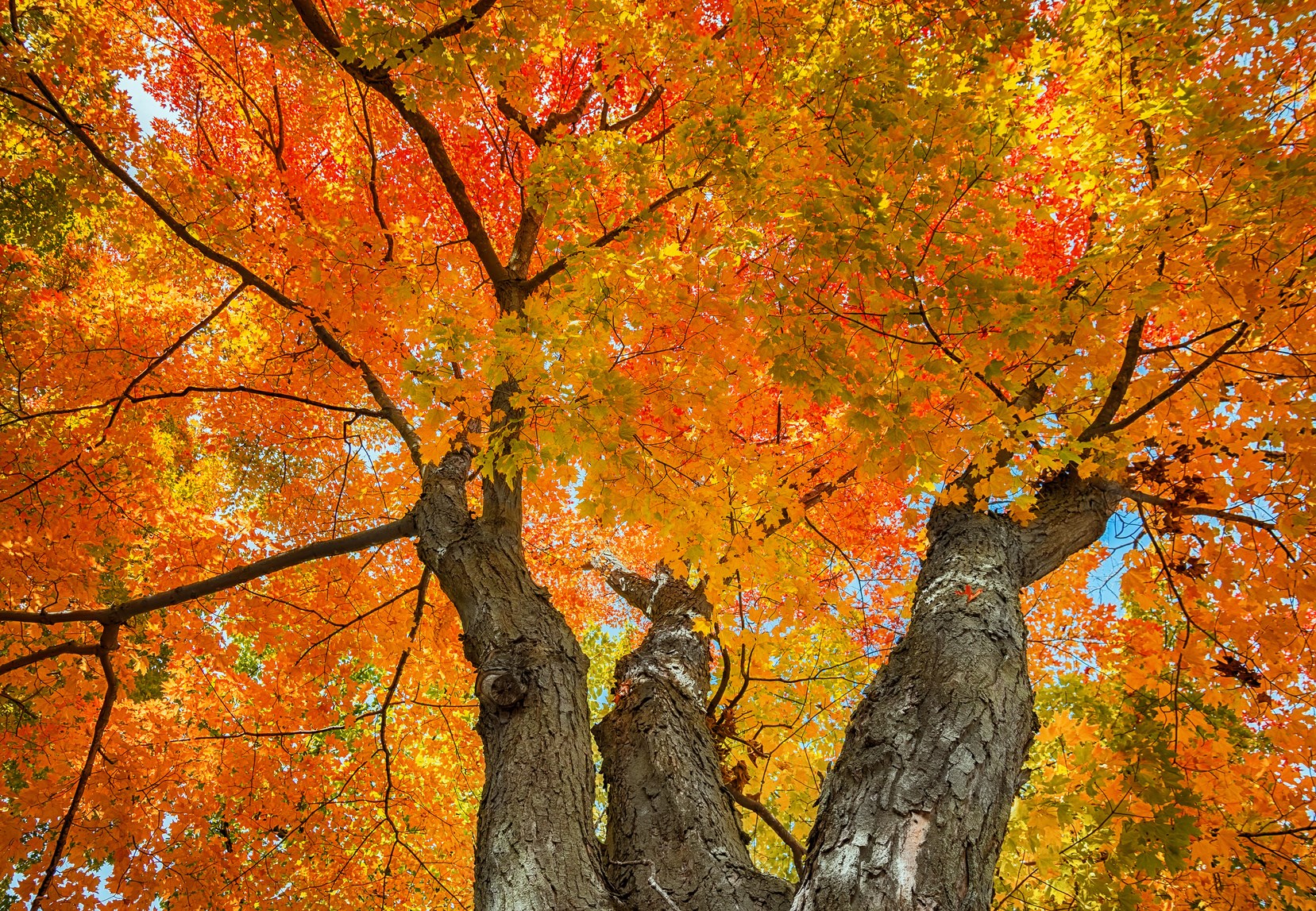How sugar maple trees work
Explaining Sap Flow
Sap flow from sugar maples is entirely temperature dependent. A rise in temperature of the sapwood to above 32 degrees F. causes a positive pressure within the wood. This pressure produces the sap flow. Many people assume that maple sap flows up from the tree’s roots on warm days. Actually—on warm spring days which follow cold nights—sap can flow down from the maple tree’s branches and then out the spout. The sap can also flows back and forth laterally within the tree. It will flow out a hole drilled into the tree or out through a broken or cut branch. The internal pressure of the tree, when it is greater than the atmospheric pressure, causes the sap to flow out, much the same way blood flows out of a cut. If you visualize a portion of a tree trunk as being under positive pressure, a taphole is like a leak, sap moves towards the point of lowest pressure from all directions.
under pressure
The exact mechanism for the production of the pressure is not completely understood, although several hypotheses have been advanced. None of these seem to fit all the requirements for explaining the sap flow. Individual trees differ in the rate of response to temperature. Some immediately record a jump in pressure to above 25 pounds per square inch, other react more slowly or do not reach the same magnitude of pressure. Pressures as high as 40 pounds per square inch are possible.
 When the temperature falls to near, or below freezing, the pressure may become negative in relation to atmospheric pressure. As the maple tree begins to freeze, sap is actually sucked up into the tree through the large wood pores that connect with the tree’s roots. At these times the tree is actually recharging itself with liquid from its roots. The process continues as long as there are freezing temperatures and rising sap. If the freezing period is a long and slow one, the tree will suck up a great deal of sap. The following sap run will be a good one as long as the warming temperatures cooperate as well.
When the temperature falls to near, or below freezing, the pressure may become negative in relation to atmospheric pressure. As the maple tree begins to freeze, sap is actually sucked up into the tree through the large wood pores that connect with the tree’s roots. At these times the tree is actually recharging itself with liquid from its roots. The process continues as long as there are freezing temperatures and rising sap. If the freezing period is a long and slow one, the tree will suck up a great deal of sap. The following sap run will be a good one as long as the warming temperatures cooperate as well.
Unfortunately, even this explanation does not make much sense when one considers that water expands as it freezes. If this is true, the trees ought to push out sap when they freeze and suck it up when they thaw. This is the case for most hardwood species. However, maples suck sap as they freeze and drip sap when they thaw. Why? This negative pressure (suction) is created within the sapwood of maples as a result of sap freezing, carbon dioxide dissolving in cooled sap, and gas contraction during cooling.
 There are four longitudinal cell types in hardwood trees. These cells act as pipes, which transport sap through the living sapwood much like pipes, transport water through a house. In most hardwoods, the dead wood fibers that surround the vessel elements are filled with water. In maple trees however, these dead wood fiber cells are filled with gas. When the cells start to freeze, frost forms on the inside of the cells. After long periods of freezing weather re-charge the tree with sap, the tree will yield this sap when the weather turns warm enough to thaw out the frost in the cells. The sap can then flow down the tree via gravity and out a tap hole, or can be forced out the hole by increasing internal pressure. In this case the positive pressure inside the maple tree is a result of pressure from warming, released gasses, osmotic pressure caused by sugar and other substances in the sap, as well as gravity on the sap higher up in the tree.
There are four longitudinal cell types in hardwood trees. These cells act as pipes, which transport sap through the living sapwood much like pipes, transport water through a house. In most hardwoods, the dead wood fibers that surround the vessel elements are filled with water. In maple trees however, these dead wood fiber cells are filled with gas. When the cells start to freeze, frost forms on the inside of the cells. After long periods of freezing weather re-charge the tree with sap, the tree will yield this sap when the weather turns warm enough to thaw out the frost in the cells. The sap can then flow down the tree via gravity and out a tap hole, or can be forced out the hole by increasing internal pressure. In this case the positive pressure inside the maple tree is a result of pressure from warming, released gasses, osmotic pressure caused by sugar and other substances in the sap, as well as gravity on the sap higher up in the tree.
It must be understood that usually different parts of the tree respond at different times. After a cold night, when the sun rises and warms the southeast exposure, that portion of the tree will start to flow. Tapholes on other exposures may still be under negative pressure. As the sun moves around the tree these other tapholes will start to flow. Sap flow will continue as long as the pressure inside the tree is greater than the atmospheric pressure outside the tree. Vacuum pumps on tubing systems show their greatest gain over gravity flow systems when tree pressures are low. This is because there is a small pressure differential between the internal tree pressure and the atmospheric pressure outside the tree. The tree responds by continuing to flow at a rate usually associated with higher tree pressures.
The period of sap flow can vary from just a few hours to a few days on end. Many environmental factors and tree metabolic factors affect the length of sap flow period and the amount of sap produced. For strong sap flows to be repeated, a suitable temperature cycle above and below freezing must occur to allow strong positive sap pressure to develop. The sap flow ceases entirely when these temperature cycles cease to exist.
Bumper sap years also depend on the growing season of the previous summer to store as much carbohydrates as possible in the form of starch. These stored starch reserves convert to sucrose and are dissolved in the sap as spring approaches. The amount of sugar (sucrose) in the springtime sap depends on many factors including tree genetics, leaf mass, site conditions, amount of sun the previous growing season and overall tree health. Proper tapping and sap collection methods will not be detrimental to a sugar maple tree. Many trees have been tapped every year for well over a hundred years.
The Seasons of Maple in Massachusetts
Spring: This is the time of the most activity when the syrup is being made and most of the harvest work is done. Most sugarhouses in Massachusetts are open to the public during the boiling season, and many have restaurants where you can have pancake breakfasts with freshly made maple syrup. Because sap must be boiled immediately to make the best syrup, sugarmakers are often boiling late into the night, and occasionally around the clock. At the end of the season, everything must be absolutely clean and in good repair before it is stored for the next season.
Summer: In the summer, chlorophyll, the green pigment in the leaves, absorbs energy from the sun and the roots absorb water and minerals from the soil. In the process of photosynthesis, a simple sugar is produced, which is converted to starch, and is stored within the tree. This is the maple tree’s food and energy reserve. It is also the basis for the sweet sap to be harvested nine months later. For the sugarmaker it is a time to package and sell his maple syrup. Some producers fertilize their trees, and many thin out the “weed” trees in the sugarbush, to allow room for the maples to grow.
 Autumn: As fall arrives, the days become cooler and shorter and the leaves begin to slow down their chlorophyll production. Sugar remaining in the leaves combines with other substances, and the leaves show their spectacular red and gold colors of fall. After the leaves drop it is a lot easier to work in the woods because visibility is greater, and the heat and insects of summer are gone. This is the time of the year for the sugarmaker to clean up his sugarbush, repair damage by fallen or dead trees, and to cut firewood for the house or for burning in the evaporator.
Autumn: As fall arrives, the days become cooler and shorter and the leaves begin to slow down their chlorophyll production. Sugar remaining in the leaves combines with other substances, and the leaves show their spectacular red and gold colors of fall. After the leaves drop it is a lot easier to work in the woods because visibility is greater, and the heat and insects of summer are gone. This is the time of the year for the sugarmaker to clean up his sugarbush, repair damage by fallen or dead trees, and to cut firewood for the house or for burning in the evaporator.
Winter: During the winter the trees remain dormant. The starch is stored within the tree, waiting to be converted to sugar in the spring, and to sweeten the sap that the maple producer will gather. For many sugarmakers the Christmas holiday season is a time when they sell much of their product. Maple syrup has become a favorite gift of residents of New England. Massachusetts maple producers ship syrup to gift recipients all over the world. This is also the time to think about the upcoming maple season, to make improvements in the sugarbush, and to dream about new equipment.

